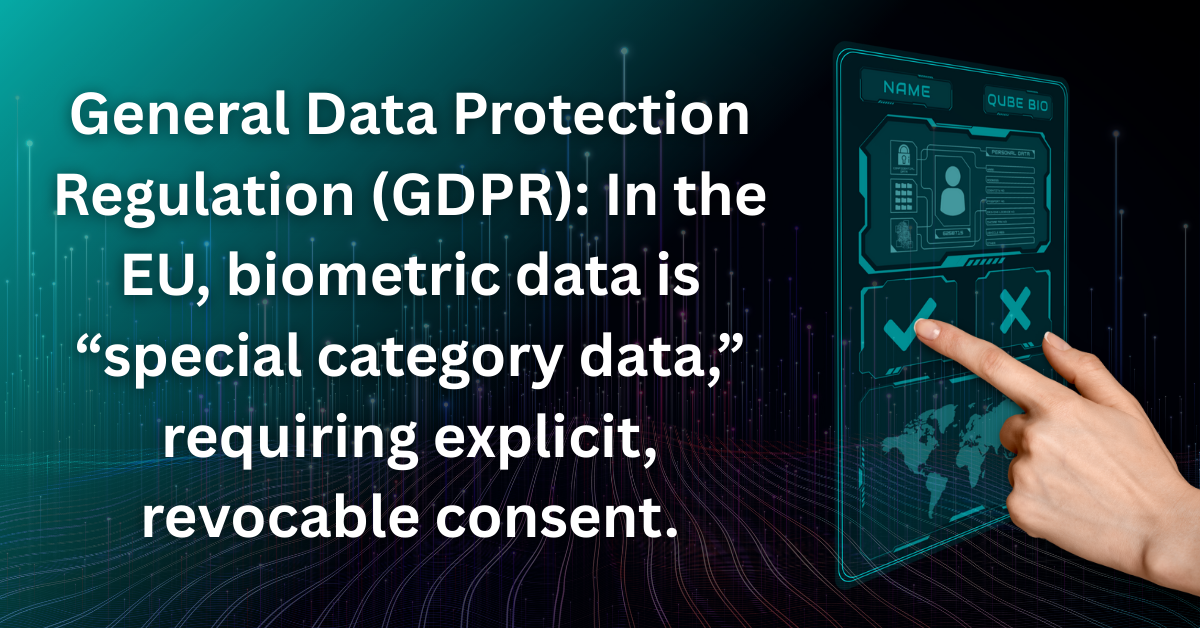Categories
Biometric technologies, such as fingerprint, facial, and palm vein recognition, are now integral to devices used in various settings, from offices to public spaces. Qube Bio’s devices, secured with AES-256 encryption and managed through centralized storage to support multiple devices and users, exemplify this trend.
Biometric consent—the explicit permission users give for their biometric data to be collected and processed—is essential for ensuring privacy and trust. This article explores what biometric consent entails, its importance, how Qube Bio implements it, and what users should know to make informed choices about their data.

Biometric consent is the affirmative agreement users provide for the collection, storage, and use of their unique physiological traits, such as fingerprints, facial scans, or palm vein patterns. It’s a critical safeguard in environments where Qube Bio’s devices are deployed across multiple locations with high user volumes.
Consent ensures users knowingly allow their biometric data to be used for purposes like authentication or identification.
Unlike passwords, biometric data is permanent, making informed consent vital to protect privacy and prevent misuse.
This framework empowers users to maintain control over their personal information in multi-device ecosystems.
Qube Bio’s devices leverage advanced biometric modalities to provide secure and efficient authentication across various settings, such as corporate offices, airports, or event venues.
Uses 3D mapping for contactless authentication, ideal for high-traffic environments.
Captures unique ridge patterns for quick access to devices or secure areas.
Employs near-infrared imaging to map vein patterns, offering high accuracy with over a million reference points.
All biometric templates are encrypted with AES-256, ensuring robust protection against unauthorized access.
Qube Bio’s systems use secure centralized storage to manage biometric templates across multiple devices and users, a necessity for environments with numerous access points.
Centralized storage requires clear communication about data handling, as users’ biometric information is not stored locally on individual devices. Consent processes must address this to maintain transparency.
Biometric consent is governed by regulations and ethical principles to ensure user rights are protected.

Qube Bio must ensure consent is voluntary, informed, and revocable. Ethical practices include clear disclosures about data use and robust security measures to maintain user trust.
Qube Bio’s consent process is designed to be user-friendly and compliant, accommodating the complexities of multi-device environments.
Users are informed about the biometric data being collected (e.g., facial scans) and its purpose (e.g., access control).
Consent requires explicit user action, such as tapping “Agree” on a device interface.
Users are notified that data is stored in a secure centralized system with AES-256 encryption.
Users can withdraw consent and request data deletion at any time, per regulatory requirements.
To navigate biometric consent effectively with Qube Bio’s devices, users can follow these steps:
Understand what data is collected and how it’s used before agreeing.
Ensure devices use AES-256 encryption and centralized storage meets industry standards.
Regularly check device settings to confirm biometric features align with your preferences.
Inquire about data retention, deletion policies, and third-party sharing to stay informed.
As biometric technologies advance, consent mechanisms will evolve to address new challenges.
Qube Bio’s focus on AES-256 encryption and centralized storage positions it to adapt to these trends while prioritizing user trust.
Biometric consent is your tool for navigating the power of Qube Bio’s fingerprint, facial, and palm vein recognition devices. By understanding how your data is encrypted with AES-256 and managed in centralized storage, you can make informed decisions that protect your privacy while enjoying seamless technology.
As biometrics shape our world, staying engaged with consent processes ensures your digital identity remains secure, giving you confidence in every scan or touch.